Sparking new life
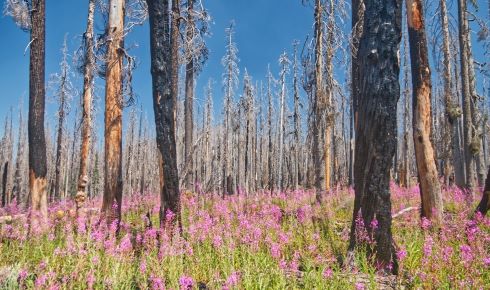
6th September 2024
Not all plants are destroyed by fire – some use it to thrive. James Romero looks at what naturally fire-prone ecosystems can teach us as large, anthropogenic wildfires become more common
Wildfires are devastating for life, but particularly for life that is unable to fly, flee or burrow. Flames can raise temperatures to more than 1,000°C, and they often follow periods of stressful drought. Severe wildfires can sterilise an ecosystem, reducing complex and established communities of fungi, microbes, plants and animals to blackened earth.
However the scenes of charred devastation after a fire can be deceiving. While no species is adapted to live in fire, fire is a natural phenomenon. How well life recovers after a wildfire depends on how much fire is a part of that particular ecosystem’s history.
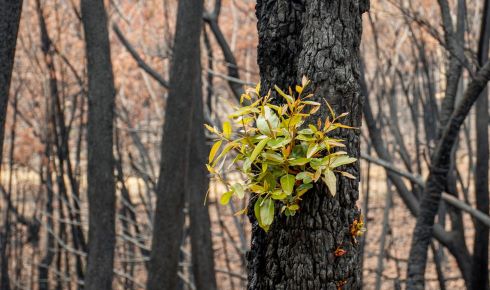 Most eucalyptus trees have dormant or ‘epicormic’ buds lying in wait beneath the bark
Most eucalyptus trees have dormant or ‘epicormic’ buds lying in wait beneath the bark
“Ever since plants came onto land over 400 million years ago, fires have been burning them,” says Kim Simpson, a postdoctoral researcher at the University of Sheffield who studies the relationship between fire and grasses. Like any challenge thrown at living things, some perish, but others adapt. The savannah ecosystems that Simpson studies are particularly fire-prone, due to the density of the grass. Its high surface-to-volume ratio also means it dries out quickly. But the grasses’ evolutionary experience with fire allows them to recover rapidly.
In the Brazilian savannahs, known as the Cerrado, grasses or sedges can appear completely burnt. And yet days later the first stems rise, sometimes with flowers. In one particularly extreme case Bulbostylis paradoxa, found from southern Brazil up to Mexico, unveils peachy-orange flowers within 24 hours of a fire.
Shoots of recovery
There are various tactics plants employ to survive and reestablish after a wildfire. The first shoots of recovery generally come from resprouting species: new buds can form on even the most blackened branch, stem or trunk, often due to an outer layer of water-retaining, fire-resistant bark protecting the living tissue inside.
“A charred landscape of tree skeletons can be misleading,” says Eric Knapp, an ecologist at the Pacific Southwest Research Station. “The bulk of that tree is not combusted… that wood is wet.”
Many Australian tree species, including most eucalyptus, have dormant or ‘epicormic’ buds lying in wait beneath the bark. However, buds can also emerge from the base of a plant, insulated from the flames by covering soil. In the forests of Wyoming, aspen can resprout when the trunk is severely damaged as long as the roots remain healthy. A similar roots-up recovery is common in shrubs such as antelope bitterbrush (Purshia tridentata), and mountain mahogany (Cercocarpus), as well as in moorland species such as bilberry (Vaccinium myrtillus).
Other recovery mechanisms involve seed germination. Seeds already in the soil are, like roots, protected from the heat of the fire, or seeds can be dispersed back into a burnt area on the wind or by returning animals. In some conifers such as knobcone pine (Pinus attenuata) and Australian Banksia trees, seeds are protected from fire within closed cones. Fire melts a sticky tree sap substance called pitch, triggering the cone to open up and drop the seeds to the floor.
There are various benefits for these green first responders. In a post-fire landscape, dead bark, wood and leaf litter have been removed. Each of these can choke plant growth and block new nutrients returning to the soil. There is also often additional light coming in from the removal of overhanging vegetation.
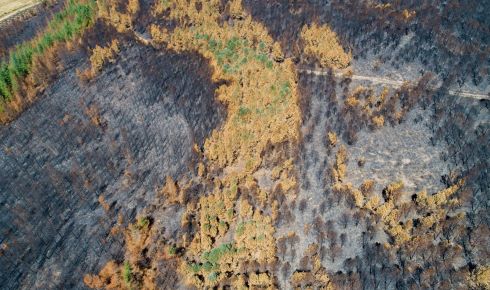 How life recovers after a wildfire depends on fire's role in a particular ecosystem’s history
How life recovers after a wildfire depends on fire's role in a particular ecosystem’s history
For some species, the flames are a lifeline: ‘pyroendemic’ plants only germinate after a fire. This group includes the Californian grassland native whispering bells (Emmenanthe penduliflora), whose germination is stimulated by chemical components of charred wood, known as karrikins¹. A similar process is seen in heathland heather (Calluna vulgaris)²; and South Africa’s fire lily (Cyrtanthus ventricosus), which produces flowering stalks just three days after exposure to smoke.
This evolutionary adaptability and opportunism means certain ecosystems owe their biodiversity to regular fires. Fire doesn’t impact all areas equally, and this variation creates a mosaic of habitats³ at different stages of recovery, each supporting their own flora and fauna. It is this dynamic tapestry of fire recovery that many indigenous communities have cultivated for hundreds or thousands of years. It has allowed them to increase regional biodiversity in a way that supports how they live.
Working with fire
The Karuk tribe has lived in the forests along the Klamath River in north western California for generations. Its traditional approach to forest management involves controlled, small-scale burns implemented at different sites on a rotational basis (see boxout, above).
Since the 1900s the Karuk people have not been allowed to manage their lands with fire as more of it was turned over to logging companies that prioritised growing Douglas firs in increasing densities. “Our lands have been turned into fibre forests,” says tribe member Kathy McCovey. “When a fire gets in there, it won’t stop,” she says. It’s not just timber – last year’s wildfires in Maui followed centuries of redevelopment of the island’s moist forests into dry, cattle-feeding prairies containing highly flammable foreign grasses such as guinea grass (Megathyrsus maximus).
Indigenous communities such as McCovey’s have shown how the use of fire can support biodiverse ecosystems. Unfortunately, today’s extreme wildfires are evidence that more recently humanity’s tendency has been to disrupt rather than maintain that delicate balance between life and flame. Partly that disruption can be traced to changing attitudes towards fire itself. In the western US where Knapp works, the forests historically burned every five to 15 years. But after a century of fire management policies aiming to take fire out of the system entirely, fuel material has piled up. “We tend to put out the fires we can put out, and that leaves only the ones we can’t,” he says.
Another reason fuel has been stacking up is the increasing influence of commercial forestry and the timber industry. Speaking last year at Toronto’s Collision Tech conference during Canada’s worst ever wildfire season, Megan Leslie, WWF-Canada’s president and CEO, said humans have weakened the resilience of forests to fire “because we’re managing them, principally for yield… What’s missing in that picture is all the other plants: the understorey, the wildflowers and shrubs and the diversity of species.”⁴
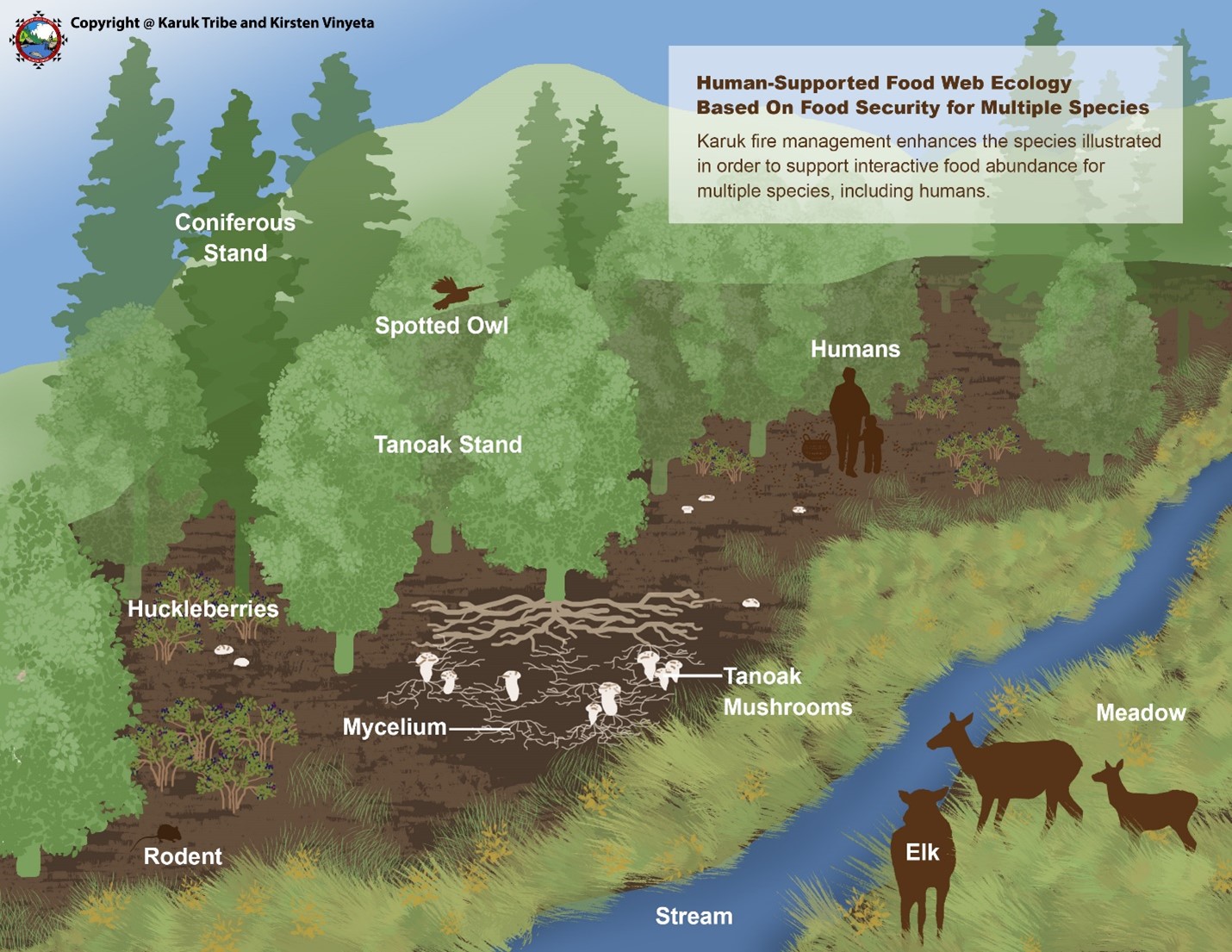 For the Karuk, fire helps create a mosaic of useful ecological diversity
For the Karuk, fire helps create a mosaic of useful ecological diversityThe Karuk tribe in California, US, has shaped the region’s ecological conditions for millennia. For them, fire is not an end point, but a kick-start to a series of localised, several-year-long recoveries where biodiversity flourishes.
Karuk tribe member Kathy McCovey’s relationship with forests started as a child, when her grandparents took her foraging within the most recently burnt lands. They would return with baskets full of fruits from opportunistic pioneer species like elderberry, hazelnuts, tanuk mushrooms and yerba buena, a mint used in traditional medicine. Sometimes they collected Indian tobacco (Lobelia inflata), whose leaves are chewed or smoked for ceremonial or medical purposes.
As time moves, on these fruit patches become brush fields. Species like California lilac (Ceanothus) shade out the pioneers but provide basket materials for Karuk weavers and fix nitrogen into the ecosystem.
This shrub land phase then offers cover to young hardwood saplings that eventually take over, producing the acorn and oak tree groves that give the Karuk their tea. And finally the hardwood gives way to conifers such as bull pine (Pinus ponderosa) and the Douglas fir (Pseudotsuga menziesii).
Finally there is climate change to factor in. Our warming world has brought more frequent and intense periods of hot, dry weather, evaporating more ground moisture. The climate emergency is not just creating more fuel, it is also providing the spark. McCovey struggles to recall many thunderstorms from her childhood. Now lightning regularly lights up the skies over the Klamath River. “A thousand strikes last year in one thunderstorm,” she recalls. “And I believe we had 136 fires.
This combination of commercially driven land use change, suppression of low-level fires, the introduction of fire-fuel grasses, and climate change can explain many of the recent uncharacteristically intense wildfires. Studies in the montane forests of the Rocky Mountains⁵ suggest more intense fires are converting forests to grass and shrublands, and these fires’ wider reach is leaving severely burnt patches too isolated to recover.
“Inward dispersal of species back into wildfire affected areas is limited if the wildfire is too widespread,” says Knapp. “Now we have wildfires where there isn’t a living tree in many square miles.”
Even when plant life does return to these forests, there is no guarantee it will resemble what came before. In rarely-burnt forests like the Amazon, tree removal by fire exposes the moisture-rich microclimate below. Grasses, or opportunistic shrubs, quickly take over, limiting opportunities for new trees, while also building up fuel reservoirs for the next fire.
In contrast, for savannahs the concern is that the managed decline of fire is now threatening fire-dependent species. “They’re becoming more wooded,” says Simpson. “It’s the reverse trend. Grassland to something that is like shrubland, and then eventually forest.”
More intense fires also have the power to impact the subterranean ecosystem, seen in both savannah and forest ecosystems. The ignition of the soil and its organic matter affects soil’s cohesiveness, leaving it more prone to erosion by rain and less able to retain moisture for plant regeneration.
Helping recovery
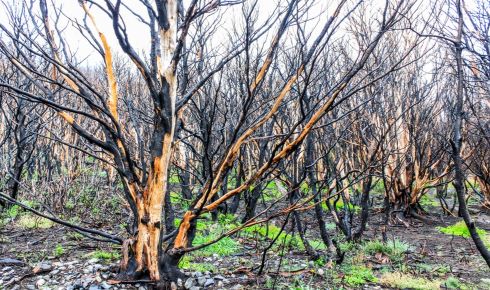 When plant life does return, there's no guarantee it will be the same as what came before
When plant life does return, there's no guarantee it will be the same as what came before
In this wildfire reality, many ecologists are looking at how humans can help ecosystems survive or recover from fires. For tree recovery, a focus on shrub restoration has proved successful in protecting and nurturing tree saplings in the hyper-localised microclimates beneath them.
Post-wildfire seeding has been trialed⁶ in the western US’s vast areas of sagebrush grasslands and proved effective. Indeed it could be even more impactful if targeted around the ‘resource islands’ that form under the canopies of damaged or even dead bushes⁷. For under-threat savannahs, a more relaxed approach to fire management could be combined with seeding of native pyroendemics to promote cyclical biodiversity when natural fires start to return.
When the Secwepemcúl’ecw Restoration and Stewardship Society reforested Elephant Hill, a nearly 200,000-hectare area in British Columbia that burned in 2017, it planted more fire-resistant deciduous trees and an understorey below the canopy. The community-led approach was grounded in indigenous knowledge and resisted pressure to plant more economically valuable trees.
The idea that wildfire recovery can be more successful if guided by indigenous peoples is growing in popularity. Technology, from satellite imaging to machine learning, is also helping us better quantify biodiversity and carbon sequestration over vast areas, enabling more robust measurement and evaluation of different conservation efforts than was ever possible before.
“If we utilise the knowledge the Karuk people have gained from their ancestors, and combine it with western science, we might be able to prepare our landscape to receive fire in its natural state without having to fight the fires,” says McCovey.
REFERENCES
1) Keeley, J. & Pausas, J. Evolution of ‘smoke’ induced seed germination in pyroendemic plants. S. Afr. J. Bot. 115, 251–255 (2018).
2) Vandvick, V. et al. Management-driven evolution in a domesticated ecosystem. Biol. Lett. 10(2), (2013).
3) Moritz, M., Batllori, E. & Bolker, B. The role of fire in terrestrial vertebrate richness patterns. Ecol. Lett. 26(4), 563–574 (2023).
4) After the fire: how technology can drive successful restoration. WWF.ca 17 August 2023.
5) Rodman, K. et al. A changing climate is snuffing out post-fire recovery in montane forests. Glob. Ecol. Biogeogr. 29(11), 2039–2051 (2020).
6) Davies, K., Bates, J. & Boyd, C. Postwildfire seeding to restore native vegetation and limit exotic annuals: an evaluation in juniper-dominated sagebrush steppe. Restor. Ecol. 27(1), 120–127 (2019).
7) Davies, K., Bates, J. & Clenet, D. Improving restoration success through microsite selection: an example with planting sagebrush seedlings after wildfire. Restor. Ecol. 28(4), 859–868 (2020).
James Romero is a UK-based science writer covering new research stories in geology, archaeology, astronomy, cosmology and planetary science. He also organises science festivals and exhibitions in his home city of London.


